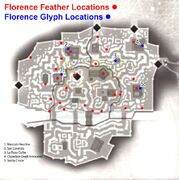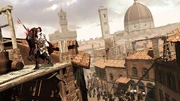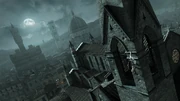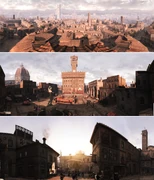No edit summary Tag: rte-source |
No edit summary |
||
| (14 intermediate revisions by 5 users not shown) | |||
| Line 1: | Line 1: | ||
| + | {{Era|Locations}} |
||
| − | {{Era|AC2|ACB|ACR|ACRG|ID|ACI|Renaissance|Rbook|CS|ACL|Embers}} |
||
{{WP-REAL}} |
{{WP-REAL}} |
||
{{Location infobox |
{{Location infobox |
||
|image = Firenzelineage.png |
|image = Firenzelineage.png |
||
| − | |state = [[Roman Republic]] and [[Roman Empire|Empire]] |
+ | |state = [[Roman Republic]] and [[Roman Empire|Empire]] {{c|59 BCE–476 CE}}<br>[[Holy Roman Empire]] {{c|774–1115}}<br>[[Republic of Florence]] {{c|1115-1532}}<br>Duchy of Florence {{c|1532–1569}}<br>Grand Duchy of Tuscany {{c|1569–1801, 1815-1859}}<br>[[French Empire]] {{c|1801-1815}}<br>[[Italy]] {{c|1870–current}} |
| − | |rulers = Republic (59-27 BCE)<br>Autocracy (27 BCE-476)<br>Monarchy (568-1115)<br> |
+ | |rulers = Republic (59-27 BCE)<br>Autocracy (27 BCE-476)<br>Monarchy (568-1115)<br>Democratic oligarchic republic (1115-1532)<br>Absolute monarchy (1532-1866) |
|factions = [[Assassins]]<br>[[Templars]]<br>[[House of Auditore]]<br>[[House of Pazzi]] |
|factions = [[Assassins]]<br>[[Templars]]<br>[[House of Auditore]]<br>[[House of Pazzi]] |
||
|founded = [[Gaius Julius Caesar|Julius Caesar]] |
|founded = [[Gaius Julius Caesar|Julius Caesar]] |
||
|date = 59 BCE |
|date = 59 BCE |
||
|landmark = [[Basilica di Santa Maria del Fiore|Santa Maria del Fiore]]<br>[[Basilica di Santa Maria Novella|Santa Maria Novella]]<br>[[Ponte Vecchio]]<br>[[Palazzo Auditore]]<br>[[Palazzo della Signoria|Palazzo Vecchio]] |
|landmark = [[Basilica di Santa Maria del Fiore|Santa Maria del Fiore]]<br>[[Basilica di Santa Maria Novella|Santa Maria Novella]]<br>[[Ponte Vecchio]]<br>[[Palazzo Auditore]]<br>[[Palazzo della Signoria|Palazzo Vecchio]] |
||
| − | |targets = [[Uberto Alberti]]<br>[[Francesco de' Pazzi]]<br>Girolamo Savonarola<br>[[Painter|The Painter]]<br>[[Doctor (Savonarola's lieutenant)|The Doctor]]<br>[[Preacher|The Preacher]]<br>[[Farmer|The Farmer]]<br>[[Condottiero|The Condottiero]]<br>[[Merchant (Savonarola's lieutenant)|The Merchant]]<br>[[Nobleman|The Nobleman]]<br>[[Priest (Savonarola's lieutenant)|The Priest]]<br>[[Guard Captain|The Captain Guard]] |
+ | |targets = [[Uberto Alberti]]<br>[[Francesco de' Pazzi]]<br>[[Girolamo Savonarola]]<br>[[Painter|The Painter]]<br>[[Doctor (Savonarola's lieutenant)|The Doctor]]<br>[[Preacher|The Preacher]]<br>[[Farmer|The Farmer]]<br>[[Condottiero|The Condottiero]]<br>[[Merchant (Savonarola's lieutenant)|The Merchant]]<br>[[Nobleman|The Nobleman]]<br>[[Priest (Savonarola's lieutenant)|The Priest]]<br>[[Guard Captain|The Captain Guard]] |
| + | }} |
||
| − | '''Florence''' (Italian: ''Firenze'') is a major city located in central [[Italy]], and the capital of the region of [[Tuscany]]. During the late 15th century, the city was ruled by |
+ | '''Florence''' (Italian: ''Firenze'') is a major city located in central [[Italy]], and the capital of the region of [[Tuscany]]. During the late 15th century, the city was ruled by the powerful [[House of Medici|Medici family]], and comprised four districts: [[Santa Maria Novella District|Santa Maria Novella]], [[San Giovanni District|San Giovanni]], [[San Marco District (Florence)|San Marco]], and [[Oltrarno District|Oltrarno]]. |
| − | + | For a brief time, however, the city fell into a dark age of sorts with the [[Bonfire of the Vanities]], when, under the command of [[Girolamo Savonarola]], thousands of objects such as cosmetics, art, and books deemed occasions of sin were destroyed. |
|
==History== |
==History== |
||
===Early development=== |
===Early development=== |
||
| − | Florence was founded during the [[Roman |
+ | Florence was founded by [[Julius Caesar]] during the [[Roman Republic|Republic]] era, in the year 59 BCE, although it would be some 1,400 years before it developed into one of Italy's most important cities. After the sacking of [[Rome]] in the 5th century, the {{Wiki|Ostrogoths}} took over. Under their rule, the city was constantly under attack from the [[Byzantine Empire|Byzantines]], who sent the population level below 1,000. However, the Lombards came to power in the 6th century, ending the Byzantine assaults.<ref name="Database">''[[Assassin's Creed II]]'' – [[Database: Firenze]]</ref> |
| − | Early in the city's history, it, like many other cities, attempted to gain control of the surrounding lands and towns. Two such areas were [[Monteriggioni]] to the north and Pisa to the west. Although the former maintained a shaky alliance with Florence afterwards, it would be years before Pisa would follow suit. Florentine heralds often spread the news of Pisa's demonstrations of contempt to Florence.<ref name="AC2"/> |
+ | Early in the city's history, it, like many other cities, attempted to gain control of the surrounding lands and towns. Two such areas were [[Monteriggioni]] to the north and Pisa to the west. Although the former maintained a shaky alliance with Florence afterwards, it would be years before Pisa would follow suit. Florentine heralds often spread the news of Pisa's demonstrations of contempt to Florence.<ref name="AC2">''Assassin's Creed II''</ref> |
| − | Florence grew to a population of 80,000 in the 14th century, of which 25,000 were working in the wool industry. In 1378, a major revolt of the lower class led to the wool combers rising up and seizing the government of the city. Their progressive, radical democracy lasted for less than two months before the upper classes seized control once more, but the revolt so terrified the rich it was still discussed in hushed tones a century later.<ref name=" |
+ | Florence grew to a population of 80,000 in the 14th century, of which 25,000 were working in the wool industry. In 1378, a major revolt of the lower class led to the wool combers rising up and seizing the government of the city. Their progressive, radical democracy lasted for less than two months before the upper classes seized control once more, but the revolt so terrified the rich it was still discussed in hushed tones a century later.<ref name="Database" /> |
| − | The Albizzi family became the de facto rulers after the revolt. Worried about the rise of the Medici family, who were rich bankers rapidly gaining influence in Florence, Maso and Rinaldo Albizzi imprisoned |
+ | The Albizzi family became the de facto rulers after the revolt. Worried about the rise of the Medici family, who were rich bankers rapidly gaining influence in Florence, Maso and Rinaldo Albizzi imprisoned [[Cosimo de' Medici]] and exiled him in 1433.<ref name="Database"/> |
| − | However, Cosimo gained influence behind the scenes, and rose to power in 1434, exiling the entire Albizzi family except for Luca, who had been loyal to Cosimo. Luca Albizzi joined the Signoria, the ruling body of Florence, as Gonfaloniere, succeeding Cosimo's old friend [[Ilario Auditore]] in 1442.<ref name=" |
+ | However, Cosimo gained influence behind the scenes, and rose to power in 1434, exiling the entire Albizzi family except for Luca, who had been loyal to Cosimo. Luca Albizzi joined the Signoria, the ruling body of Florence, as Gonfaloniere, succeeding Cosimo's old friend [[Ilario Auditore]] in 1442.<ref name="Database"/> |
===Medici rule=== |
===Medici rule=== |
||
| − | After Cosimo de' Medici's revolt, the Medici family governed the city in what would come to be known as its Golden Age; a true [[Renaissance]]. The family had a focus on the arts and sciences, as well as an intricate banking system. At the time, the city was also home to some of Italy's most notable figures; including [[Leonardo da Vinci]], {{Wiki|Sandro Botticelli}}, [[Michelangelo]], and [[Niccolò Machiavelli]], some of whom received funding from the Medici for their works.<ref name=" |
+ | After Cosimo de' Medici's revolt, the Medici family governed the city in what would come to be known as its Golden Age; a true [[Renaissance]]. The family had a focus on the arts and sciences, as well as an intricate banking system. At the time, the city was also home to some of Italy's most notable figures; including [[Leonardo da Vinci]], {{Wiki|Sandro Botticelli}}, [[Michelangelo]], and [[Niccolò Machiavelli]], some of whom received funding from the Medici for their works.<ref name="Database"/> |
| − | At some point after the year |
+ | At some point after the year 1324, the [[Assassins|Assassin]] [[Domenico Auditore|Domenico]] and his son [[Renato Auditore|Renato]] came to live in Florence, and adopted the name of "[[House of Auditore|Auditore]]". Under this guise of nobility, they quickly assimilated themselves into the city's upper class, and became a well-respected and known family in Florence.<ref>''Assassin's Creed II'' - [[Auditore Family Crypt]]</ref> |
The city flourished during the reign of Lorenzo de' Medici. Throughout his rule, great artists, philosophers, and others contributed to the city's development. Various architectural marvels blessed the streets of Florence, such as the [[Basilica di Santa Maria Novella|Santa Maria Novella]], the [[Piazza della Signoria]], the [[Basilica di Santa Maria del Fiore|Duomo]], and the [[Ponte Vecchio]].<ref name="AC2"/> |
The city flourished during the reign of Lorenzo de' Medici. Throughout his rule, great artists, philosophers, and others contributed to the city's development. Various architectural marvels blessed the streets of Florence, such as the [[Basilica di Santa Maria Novella|Santa Maria Novella]], the [[Piazza della Signoria]], the [[Basilica di Santa Maria del Fiore|Duomo]], and the [[Ponte Vecchio]].<ref name="AC2"/> |
||
| Line 38: | Line 39: | ||
Eventually, the Medici's extravagant lifestyle drew the ire of the middle and lower classes and their popularity waned. After the death of Lorenzo de' Medici in 1492, he was succeeded by his son, [[Piero de' Medici|Piero]]. Piero ruled as Signore of Florence until 1494, when he was exiled from the city by Girolamo Savonarola.<ref>''[[Assassin's Creed: Renaissance]]''</ref> |
Eventually, the Medici's extravagant lifestyle drew the ire of the middle and lower classes and their popularity waned. After the death of Lorenzo de' Medici in 1492, he was succeeded by his son, [[Piero de' Medici|Piero]]. Piero ruled as Signore of Florence until 1494, when he was exiled from the city by Girolamo Savonarola.<ref>''[[Assassin's Creed: Renaissance]]''</ref> |
||
| + | In 1493, [[Bonacolto Contarini]], a Templar and member of the famed {{Wiki|Contarini}} noble family from [[Venice]], travelled to Florence to attempt a resurgence of the Templar influence in city. Using his family's riches and influence, he strong armed merchants and officials who sided with the Templars while imprisoning those who resisted, intending to sell them off to foreign slavers. In response, Ezio returned to Florence with assistance from [[Corvo Antonelli]], [[Perina di Bastian]] and the [[Spanish Brotherhood of Assassins|Spanish Brotherhood]] to stop Bonacolto's operations, destroying the Templar presence once again.<ref>''[[Assassin's Creed: Rebellion]]'' – ''[[A War in the Shadows]]''</ref> |
||
| ⚫ | Between 1497 and 1498, the monk instigated the Bonfire of the Vanities, where paintings, books, and other works of art were publicly burned throughout Florence. Despite civil unrest, Savonarola held control over the people with both the [[ |
||
| + | |||
| ⚫ | Between 1497 and 1498, the monk instigated the Bonfire of the Vanities, where paintings, books, and other works of art were publicly burned throughout Florence. Despite civil unrest, Savonarola held control over the people with both the [[Apple of Eden 6|Apple of Eden]], and the terror of his nine lieutenants.<ref name="AC2 - Bonfire">''Assassin's Creed II'' – ''[[Bonfire of the Vanities (DLC)]]''</ref> |
||
Eventually, in May of 1498, the Assassin Order intervened in his rule. Ezio Auditore tracked down and killed Savonarola's nine lieutenants, while Niccolò Machiavelli, [[La Volpe]], and [[Paola]] rallied the citizens. The Florentine people eventually rioted before Savonarola's residence in the [[Palazzo Pitti]], dragging him to the Piazza della Signoria to be burned at the stake.<ref name="AC2 - Bonfire"/> |
Eventually, in May of 1498, the Assassin Order intervened in his rule. Ezio Auditore tracked down and killed Savonarola's nine lieutenants, while Niccolò Machiavelli, [[La Volpe]], and [[Paola]] rallied the citizens. The Florentine people eventually rioted before Savonarola's residence in the [[Palazzo Pitti]], dragging him to the Piazza della Signoria to be burned at the stake.<ref name="AC2 - Bonfire"/> |
||
| Line 72: | Line 75: | ||
**Palazzo Pitti |
**Palazzo Pitti |
||
</div> |
</div> |
||
| + | |||
{{-}} |
{{-}} |
||
| + | |||
==Trivia== |
==Trivia== |
||
| − | *In ''[[Assassin's Creed II]]'', a real world landmark, the {{Wiki|Battistero di San Giovanni}} was missing from the piazza in front of the Santa Maria del Fiore, despite being built several hundred years before the events of the game. [[Ubisoft]] explained that the Baptistry's omission was due to hardware limitations.<ref>[http://www.1up.com/features/filling-assassin-creed-historical-world 1UP: ''Filling Assassin's Creed Historical World]</ref> |
+ | *In ''[[Assassin's Creed II]]'', a real world landmark, the {{Wiki|Battistero di San Giovanni}} was missing from the piazza in front of the Santa Maria del Fiore, despite being built several hundred years before the events of the game. [[Ubisoft]] explained that the Baptistry's omission was due to hardware limitations.<ref>[http://www.1up.com/features/filling-assassin-creed-historical-world 1UP: ''Filling Assassin's Creed Historical World]''</ref> |
*Florence also appeared in four of Ezio's suppressed Cristina Memories. |
*Florence also appeared in four of Ezio's suppressed Cristina Memories. |
||
| − | *During the Bonfire of the Vanities sequence, the sky over Florence was covered by dark clouds, presumably from the smoke coming from continuous burning of |
+ | *During the Bonfire of the Vanities sequence, the sky over Florence was covered by dark clouds, presumably from the smoke coming from continuous burning of Renaisance material. |
==Gallery== |
==Gallery== |
||
| Line 88: | Line 93: | ||
EzioFlorence.png|Ezio surveying Florence from a [[Viewpoints|view point]] |
EzioFlorence.png|Ezio surveying Florence from a [[Viewpoints|view point]] |
||
EzioFlorenceguard.jpg|Ezio killing a [[Guards|guard]] on a Florentine rooftop |
EzioFlorenceguard.jpg|Ezio killing a [[Guards|guard]] on a Florentine rooftop |
||
| − | + | ACII Ezio in Florence.jpg|Ezio in Florence at night |
|
Florence Panoramas.png |
Florence Panoramas.png |
||
Assassins Creed 2 panoramas.png |
Assassins Creed 2 panoramas.png |
||
AC2FirenzeDB.png|Florence's Database Icon |
AC2FirenzeDB.png|Florence's Database Icon |
||
| + | ACIdentity Firenze.png|Database image of Firenze in ''[[Assassin's Creed: Identity]]'' |
||
</gallery> |
</gallery> |
||
| + | |||
| + | ==Appearances== |
||
| + | *''[[Assassin's Creed: Lineage]]'' {{1st}} |
||
| + | *''[[Assassin's Creed II]]'' |
||
| + | **''[[Bonfire of the Vanities (DLC)|Bonfire of the Vanities]]'' |
||
| + | *''[[Assassin's Creed: Renaissance]]'' |
||
| + | *''[[Assassin's Creed: Brotherhood]]'' {{Mo}} |
||
| + | *''[[Assassin's Creed: Revelations]]'' {{Mo}} |
||
| + | *[[Assassin's Creed: Revelations (novel)|''Assassin's Creed: Revelations'' novel]] {{Mo}} |
||
| + | *''[[Assassin's Creed: Embers]]'' |
||
| + | *''[[Assassin's Creed: Rogue]]'' {{Mo}} |
||
| + | *''[[Assassin's Creed: Identity]]'' |
||
| + | *''[[Assassin's Creed (Titan Comics)|Assassin's Creed]]'' |
||
| + | *''[[Assassin's Creed: Rebellion]]'' – ''[[A War in the Shadows]]'' |
||
==References== |
==References== |
||
| Line 100: | Line 120: | ||
{{ACComic}} |
{{ACComic}} |
||
| + | [[de:Florenz]] |
||
| + | [[es:Florencia]] |
||
| + | [[fr:Florence]] |
||
| + | [[hu:Firenze]] |
||
| + | [[it:Firenze]] |
||
| + | [[pl:Florencja]] |
||
| + | [[pt-br:Florença]] |
||
| + | [[ru:Флоренция]] |
||
[[uk:Флоренція]] |
[[uk:Флоренція]] |
||
| + | [[zh:佛罗伦萨]] |
||
[[Category:Florence| ]] |
[[Category:Florence| ]] |
||
[[Category:Tuscany]] |
[[Category:Tuscany]] |
||
| Line 108: | Line 137: | ||
[[Category:Secondary stage locations]] |
[[Category:Secondary stage locations]] |
||
[[Category:Cities in Italy]] |
[[Category:Cities in Italy]] |
||
| + | [[Category:Italian city-states]] |
||
| + | [[Category:Port cities]] |
||
Revision as of 18:28, 28 June 2020
Florence (Italian: Firenze) is a major city located in central Italy, and the capital of the region of Tuscany. During the late 15th century, the city was ruled by the powerful Medici family, and comprised four districts: Santa Maria Novella, San Giovanni, San Marco, and Oltrarno.
For a brief time, however, the city fell into a dark age of sorts with the Bonfire of the Vanities, when, under the command of Girolamo Savonarola, thousands of objects such as cosmetics, art, and books deemed occasions of sin were destroyed.
History
Early development
Florence was founded by Julius Caesar during the Republic era, in the year 59 BCE, although it would be some 1,400 years before it developed into one of Italy's most important cities. After the sacking of Rome in the 5th century, the Ostrogoths took over. Under their rule, the city was constantly under attack from the Byzantines, who sent the population level below 1,000. However, the Lombards came to power in the 6th century, ending the Byzantine assaults.[1]
Early in the city's history, it, like many other cities, attempted to gain control of the surrounding lands and towns. Two such areas were Monteriggioni to the north and Pisa to the west. Although the former maintained a shaky alliance with Florence afterwards, it would be years before Pisa would follow suit. Florentine heralds often spread the news of Pisa's demonstrations of contempt to Florence.[2]
Florence grew to a population of 80,000 in the 14th century, of which 25,000 were working in the wool industry. In 1378, a major revolt of the lower class led to the wool combers rising up and seizing the government of the city. Their progressive, radical democracy lasted for less than two months before the upper classes seized control once more, but the revolt so terrified the rich it was still discussed in hushed tones a century later.[1]
The Albizzi family became the de facto rulers after the revolt. Worried about the rise of the Medici family, who were rich bankers rapidly gaining influence in Florence, Maso and Rinaldo Albizzi imprisoned Cosimo de' Medici and exiled him in 1433.[1]
However, Cosimo gained influence behind the scenes, and rose to power in 1434, exiling the entire Albizzi family except for Luca, who had been loyal to Cosimo. Luca Albizzi joined the Signoria, the ruling body of Florence, as Gonfaloniere, succeeding Cosimo's old friend Ilario Auditore in 1442.[1]
Medici rule
After Cosimo de' Medici's revolt, the Medici family governed the city in what would come to be known as its Golden Age; a true Renaissance. The family had a focus on the arts and sciences, as well as an intricate banking system. At the time, the city was also home to some of Italy's most notable figures; including Leonardo da Vinci, Sandro Botticelli, Michelangelo, and Niccolò Machiavelli, some of whom received funding from the Medici for their works.[1]
At some point after the year 1324, the Assassin Domenico and his son Renato came to live in Florence, and adopted the name of "Auditore". Under this guise of nobility, they quickly assimilated themselves into the city's upper class, and became a well-respected and known family in Florence.[3]
The city flourished during the reign of Lorenzo de' Medici. Throughout his rule, great artists, philosophers, and others contributed to the city's development. Various architectural marvels blessed the streets of Florence, such as the Santa Maria Novella, the Piazza della Signoria, the Duomo, and the Ponte Vecchio.[2]
Though the Assassin-affiliated Auditore family abandoned Florence after the Pazzi conspiracy in 1476, one of its members, Ezio Auditore da Firenze, continued to frequent the city.[2] During the early 16th century, he would also send his apprentices to Florence to complete several contracts for the Assassin Order; such as delivering reports, stealing weapons, or delivering forged pardons.[4]
Bonfire of the Vanities
Eventually, the Medici's extravagant lifestyle drew the ire of the middle and lower classes and their popularity waned. After the death of Lorenzo de' Medici in 1492, he was succeeded by his son, Piero. Piero ruled as Signore of Florence until 1494, when he was exiled from the city by Girolamo Savonarola.[5]
In 1493, Bonacolto Contarini, a Templar and member of the famed Contarini noble family from Venice, travelled to Florence to attempt a resurgence of the Templar influence in city. Using his family's riches and influence, he strong armed merchants and officials who sided with the Templars while imprisoning those who resisted, intending to sell them off to foreign slavers. In response, Ezio returned to Florence with assistance from Corvo Antonelli, Perina di Bastian and the Spanish Brotherhood to stop Bonacolto's operations, destroying the Templar presence once again.[6]
Between 1497 and 1498, the monk instigated the Bonfire of the Vanities, where paintings, books, and other works of art were publicly burned throughout Florence. Despite civil unrest, Savonarola held control over the people with both the Apple of Eden, and the terror of his nine lieutenants.[7]
Eventually, in May of 1498, the Assassin Order intervened in his rule. Ezio Auditore tracked down and killed Savonarola's nine lieutenants, while Niccolò Machiavelli, La Volpe, and Paola rallied the citizens. The Florentine people eventually rioted before Savonarola's residence in the Palazzo Pitti, dragging him to the Piazza della Signoria to be burned at the stake.[7]
Modern times
In 2012, Florence was used as a simulated training location by Abstergo Industries during the first[4] and second stage of their Animi Training Program, being introduced to the latter via a system update.[8]
The simulation depicted the Mercato Vecchio, a well-known marketplace in Florence's Santa Maria Novella district, and the surrounding area, which featured lots of narrow alleys, allowing for a quick escape when necessary. Visitors could take a break from the vendors' noisy shouting by reclining on the benches in one of the area's relaxing courtyards. Construction was in progress on some of the rooftops, with hanging platforms having been set up, which allowed people to move easily from the encircling buildings to the Mercato Vecchio itself.[4]
Florence, like most of the simulated locations in the first and second stage, had two aesthetic variations. As such, it could be utilized during the day or the night.[4]
An Assassin cell led by Adriano Maestranzi was located in Florence by 2012. However, the Templar Juhani Otso Berg managed to follow the Assassin Harlan Cunningham back to the cell. Berg and Sigma Team attacked the Assassin hideout, although Maestranzi blew it up, killing everyone except Cunningham and Berg.[9]
Landmarks
- Santa Maria Novella District
- Mercato Vecchio
- Santa Maria Novella
- Basilica di San Lorenzo
- San Marco District
- San Giovanni District
- Oltrarno District
- Palazzo Pitti
Trivia
- In Assassin's Creed II, a real world landmark, the Battistero di San Giovanni was missing from the piazza in front of the Santa Maria del Fiore, despite being built several hundred years before the events of the game. Ubisoft explained that the Baptistry's omission was due to hardware limitations.[10]
- Florence also appeared in four of Ezio's suppressed Cristina Memories.
- During the Bonfire of the Vanities sequence, the sky over Florence was covered by dark clouds, presumably from the smoke coming from continuous burning of Renaisance material.
Gallery
Appearances
- Assassin's Creed: Lineage (first appearance)
- Assassin's Creed II
- Assassin's Creed: Renaissance
- Assassin's Creed: Brotherhood (mentioned only)
- Assassin's Creed: Revelations (mentioned only)
- Assassin's Creed: Revelations novel (mentioned only)
- Assassin's Creed: Embers
- Assassin's Creed: Rogue (mentioned only)
- Assassin's Creed: Identity
- Assassin's Creed
- Assassin's Creed: Rebellion – A War in the Shadows
References
- ↑ 1.0 1.1 1.2 1.3 1.4 Assassin's Creed II – Database: Firenze
- ↑ 2.0 2.1 2.2 Assassin's Creed II
- ↑ Assassin's Creed II - Auditore Family Crypt
- ↑ 4.0 4.1 4.2 4.3 Assassin's Creed: Brotherhood
- ↑ Assassin's Creed: Renaissance
- ↑ Assassin's Creed: Rebellion – A War in the Shadows
- ↑ 7.0 7.1 Assassin's Creed II – Bonfire of the Vanities (DLC)
- ↑ Assassin's Creed: Revelations
- ↑ Assassin's Creed: Initiates
- ↑ 1UP: Filling Assassin's Creed Historical World
| |||||||||||||||||||||||||||||||||||||
| |||||||||||||||||||||||||||||||













